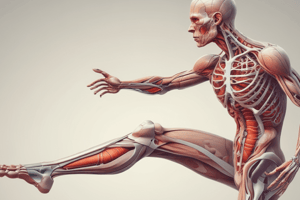Podcast
Questions and Answers
In which mode are dialyzers typically operated today?
In which mode are dialyzers typically operated today?
- Diffusion mode
- Countercurrent flow mode (correct)
- Constant concentration gradient mode
- Cocurrent flow mode
What is the impact of cocurrent flow mode on the clearance of smaller molecules?
What is the impact of cocurrent flow mode on the clearance of smaller molecules?
- Decreases clearance by 10% (correct)
- Increases clearance by 10%
- Maintains constant clearance
- Clearance remains unchanged
What is the Sieving coefficient for larger molecules in exemplary dialyzers?
What is the Sieving coefficient for larger molecules in exemplary dialyzers?
- 59%
- Constant
- Not mentioned in the text
- 10% (correct)
What does the sieving coefficient (S) represent?
What does the sieving coefficient (S) represent?
What is the fractional excretion (FE) defined as?
What is the fractional excretion (FE) defined as?
What does renal blood flow (RBF) represent?
What does renal blood flow (RBF) represent?
What is the primary function of the cells in the proximal tubule in relation to the acid-base balance?
What is the primary function of the cells in the proximal tubule in relation to the acid-base balance?
How does the kidney regulate the balance in case of alkalosis?
How does the kidney regulate the balance in case of alkalosis?
What is the role of the lungs in regulating the acid-base balance?
What is the role of the lungs in regulating the acid-base balance?
What is the primary function of renal blood flow (RBF) in relation to kidney parameters?
What is the primary function of renal blood flow (RBF) in relation to kidney parameters?
Flashcards are hidden until you start studying
Study Notes
Dialyzer Operation
- Dialyzers are typically operated in countercurrent flow mode today.
Clearance of Small Molecules
- Cocurrent flow mode decreases the clearance of smaller molecules.
Sieving Coefficient
- The sieving coefficient (S) represents the ability of a dialyzer to remove molecules of a specific size.
- For larger molecules, the sieving coefficient (S) is typically lower in exemplary dialyzers.
Renal Function
- Renal blood flow (RBF) represents the amount of blood that flows through the kidneys.
- Primary function of RBF is to regulate kidney parameters such as filtration rate and waste removal.
Acid-Base Balance
- Cells in the proximal tubule play a crucial role in maintaining acid-base balance by reabsorbing bicarbonate and eliminating hydrogen ions.
- In cases of alkalosis, the kidney regulates the balance by increasing hydrogen ion excretion and decreasing bicarbonate reabsorption.
Respiratory Regulation
- Lungs play a vital role in regulating the acid-base balance by removing carbon dioxide through exhalation, which helps to reduce hydrogen ion concentration in the blood.
Studying That Suits You
Use AI to generate personalized quizzes and flashcards to suit your learning preferences.



